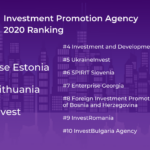The COVID-19 crisis brought unprecedented changes to the economy, largely due to the strict social distancing measures adopted by governments to limit the spread of the virus. Investment flows across Romania are expected to decline, but there is still room for optimism: foreign direct investment (FDI) could represent a central driving force for post-pandemic economic growth.
But for this to happen, Romania will have to reshape its approach towards attracting FDI in order to increase its attractiveness for foreign investors. This will be a complex process considering the fact that the intense competition among countries to attract and retain FDI is the most important challenge currently faced by International Promotion Agencies (IPAs) like Invest Romania. The COVID-19 pandemic has led to major economic disruptions across the globe. Nevertheless, it is still relevant to understand Romania’s pre-crisis FDI dynamics in order to fully grasp current and future trends.
The greenfield investment indicator
The value of greenfield investment project announcements – an indicator of future FDI trends – recorded a bigger fall (-49 percent) in developing economies like Romania than it did in developed economies (-17 percent), reflecting developing countries’ more limited capacity to roll out economic support packages, according to UNCTAD’s latest Global Investment Trends Monitor. Greenfield investments are important because such projects are developed by companies building their business from the ground up on a new market, indicating that they are there to stay.
Investors are cautious, but not fully retreating
In Romania, 46 percent of investors have cancelled, reduced or paused their planned investments, while 51 percent made no changes to their investment plans, according to the EY Attractiveness Survey on Romania. Looking to the future, investors are still optimistic and believe that Romania will become more attractive after the COVID-19 pandemic ends. Supply chain (35 percent) and manufacturing operations (36 percent) are regarded as the country’s main investment attractions. To increase its competitiveness, most foreign investors believe that Romania should highlight its agriculture and IT assets. Romania should focus its efforts on funding key issues like education, technological transformation, and infrastructure.
A possible solution from Invest Romania
The role of investment promotion agencies is becoming more important right now, and Romania could learn a lot from other countries’ governmental agencies focused on attracting new FDI. A recent UNCTAD study of 174 national IPA websites found that 64 percent of these agencies had a rapid online response to the COVID-19 pandemic, with 40 percent of IPA websites providing at least some information related to COVID-19, while 24 percent only displayed a notification informing visitors whether the IPA was still operating. Investment promotion agencies are eager to promote renewables and are increasingly inclined to digitalize their methods, according to a joint survey by the World Association of Investment Promotion Agencies (WAIPA) and the World Bank. Sector targeting is an important element of investment promotion and should be considered by the Romanian government through Invest Romania, the governmental body responsible for promoting foreign direct investment in the country. Without targeting, the government’s efforts are likely to be inefficient and unsuccessful. However, governmental promotion agencies tend to have multiple priority sectors: according to the survey findings, IPAs have 11 priority sectors on average. The most popular sectors they target are renewable energy and information technology (IT) services.
How can Romania retain its attractiveness post-COVID-19? In terms of sectors that could accelerate Romania’s development, according to EY, a majority of foreign investors mentioned agriculture (35 percent), the IT sector (29 percent), and transport and motor vehicles (21 percent).






